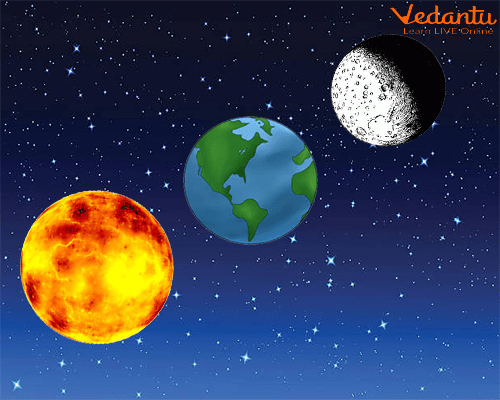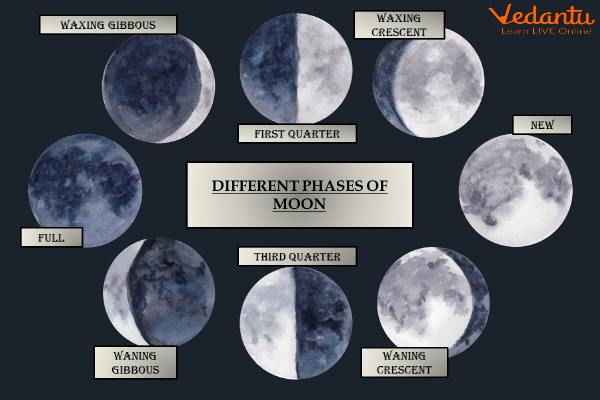




How Does the Moon Change Shape? Phases Explained
The Moon is the natural satellite of the planet Earth. It is a natural object which revolves around the Earth. It is a member of the Solar System family and is the only satellite of our planet. It is the second brightest object we see in the sky after the Sun.

The Earth, The Sun, and The Moon
The Moon does not have a light of its own. It gets its light from the Sun. It looks very beautiful on Earth. It is always surrounded by bright stars. The Moon changes its phases with every revolution around the Earth. Let us study all the concepts like how far away is the moon, what is the moon made of, and the phases of the moon for kids one by one.
Moon Earth Distance
The approximate distance between the Moon and the Earth is around 384,400 kilometres. The distance in miles is around 238,900 miles from the Earth. The moon is not that far from the Earth.
The sea level also gets affected because of the Moon. The Moon’s gravity leads to the rise and fall of the sea waves. The high tides and low tides created in the sea are affected by the gravity of the Moon.
What is the Moon Made of?
The Moon is mostly made up of rocks. There are a lot of pits present on the moon, known as craters. A lot of meteorites keep on crashing into the surface of the moon, which leads to rock and dust.
The Lunar Surface of the Moon is composed of many elements. These elements are oxygen, silicon, magnesium, calcium, aluminium, chromium, etc. Traces of water are also found on the surface of the Moon.
Phases of the Moon for Kids
The phases of the Moon change every day based on its revolution around the Earth. There are eight phases of the Moon. On a full moon day, the moon shines bright in the sky, and we often call it ‘Poornima’.

Phases of The Moon
There is a no moon day as well, where the Moon is not visible at all, and we call it ‘Amavasya’. Other than these, the other phases are New Moon, Waxing Crescent, First Quarter, Waxing Gibbous, Waning Gibbous, Third Quarter, and Waning Crescent.
Summary
The Moon shines brightly at night and can be seen from our home Earth. People go to various tourist places where they look for destinations famous for night watching. It also affects various religious and cultural activities of India. Neil Armstrong was the first person to ever land on the Moon. People have been experimenting and inventing new things on the surface of the Moon.
FAQs on Moon Facts for Kids: Everything You Need to Know
1. What is the Moon and why is it important for Earth?
The Moon is Earth's only natural satellite, which means it is a natural space object that orbits our planet. It is the fifth-largest moon in our solar system. The Moon is very important because its gravity helps create the rise and fall of our ocean tides and keeps Earth's climate stable by preventing it from wobbling too much on its axis.
2. What are some fun and interesting facts about the Moon for kids?
Here are some fun facts about the Moon that explain what makes it so special:
- No Atmosphere: The Moon has no atmosphere, which means there is no air to breathe, no wind, and no weather.
- Covered in Craters: Its surface is covered in thousands of pits called craters, which were formed by asteroids and comets crashing into it over billions of years.
- Reflects Light: The Moon does not produce its own light; it shines because it reflects the Sun's light, like a giant mirror in the sky.
- Moonquakes: Just like Earth has earthquakes, the Moon has “moonquakes,” but they are much weaker and caused by the pull of Earth's gravity.
- Always Shows the Same Face: The Moon is tidally locked with Earth, so we always see the same side of it from our planet.
3. Why does the Moon appear to change its shape every night?
The Moon doesn't actually change its shape. What we see are the phases of the Moon. As the Moon orbits the Earth, we see different amounts of its sunlit side. When the Moon is between Earth and the Sun, we see a New Moon (which is dark). When Earth is between the Sun and the Moon, we see a Full Moon (fully lit). In between, we see shapes like crescents and half-moons.
4. If the Moon has no light of its own, how can we see it from Earth?
We can see the Moon because it acts like a giant, dusty mirror in space. The bright light we see from the Moon is actually sunlight reflecting off its surface. The Sun's light travels through space, bounces off the Moon, and then travels to our eyes on Earth, making the Moon appear to glow in the night sky.
5. What is a lunar eclipse and why does it happen?
A lunar eclipse is an event that occurs when the Earth passes directly between the Sun and the Moon. When this happens, the Earth blocks the Sun's light from reaching the Moon, casting a large shadow on it. This Earth's shadow makes the Moon look dark or reddish for a short time. This can only happen during a Full Moon when the Sun, Earth, and Moon are perfectly aligned.
6. Why are there so many craters on the Moon but not as many on Earth?
This is a great question that shows a key difference between Earth and the Moon. The Moon is covered in craters because it has no atmosphere to protect it. When space rocks (meteoroids) head towards the Moon, they don't burn up and crash right into the surface. Earth, on the other hand, has a thick atmosphere that acts like a shield, burning up most rocks before they can reach the ground. Also, processes like wind and rain on Earth, called erosion, have worn away most of the craters that did form long ago.
7. Has anyone ever walked on the Moon?
Yes, people have walked on the Moon! Astronauts from the United States' Apollo missions were the first and only people to do so. The very first person to step on the Moon was astronaut Neil Armstrong on July 20, 1969. In total, 12 astronauts have walked on the lunar surface.





















